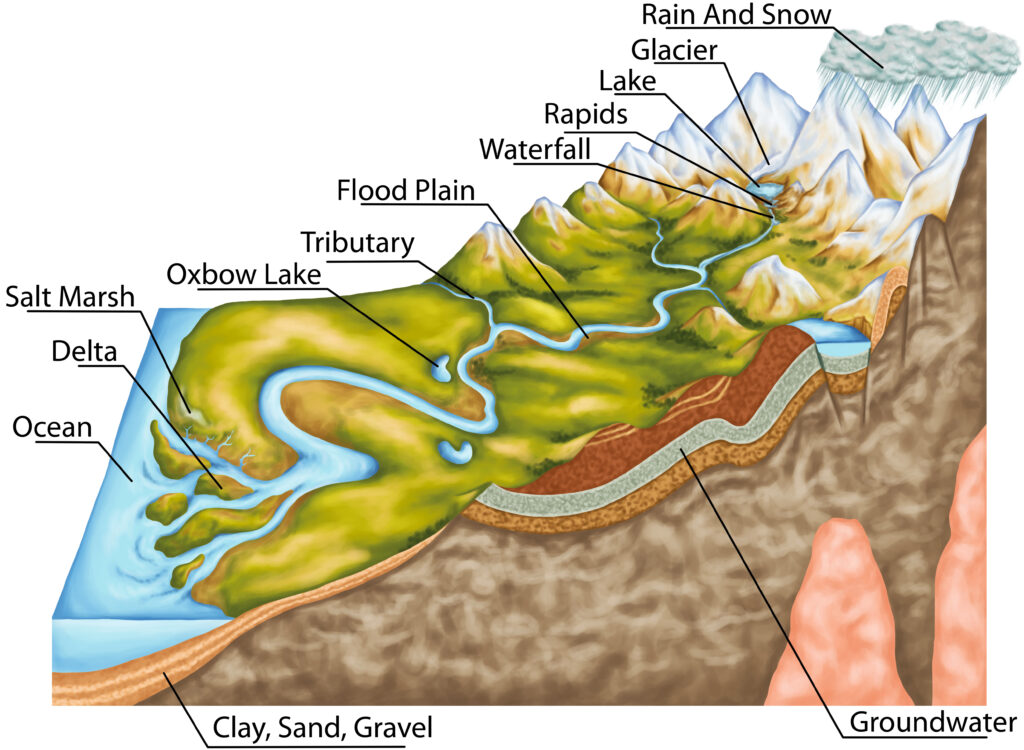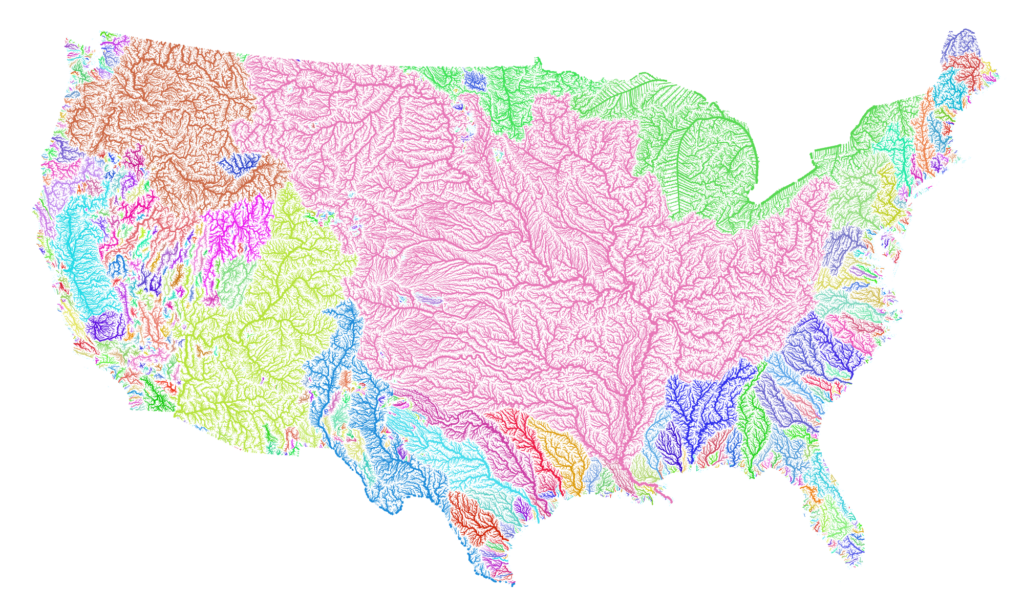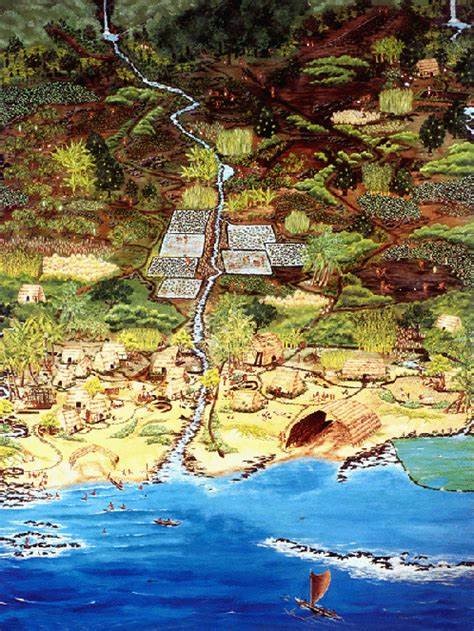By Matt Oppenheim

It was Spring of 2017 and I had broken down crying upon learning that over 2,000 refugees had drowned trying to cross the Mediterranean for the fourth year in a row. Then I thought about the ecological causes: desertification and drought, rising heat, deforestation, polluted waters, flooding, fires, and rising sea levels. I searched my soul for ways that I might help reverse this eco-holocaust. After four days I stood up strong realizing what I might contribute through my own life experience.
Through a life of experiences in watersheds, I knew that they were a fundamental fabric of our planet. Throughout the 1990s I began teaching watershed restoration and researching the impacts of watersheds on human societies. I taught creek restoration in an alternative school in Australia and then in public schools in the U.S. But I had not realized how intimate watersheds were with all life and how critical their health was to all human societies throughout history. Now, after five years of research and writing, I find that sustaining certain ecological changes will bring us back to survival and eventual resilience within a reasonable period, with progress sustained for thousands of years to come. Watersheds on our planet, whether functioning resiliently or ending up in dry deserts, are as old as time, and our human ancestors arose, evolved, and flourished as long as they treated our ecologies as mothers.
Our Watershed World
Imagine that we are above the earth looking down. Below cloud cover, mountain ranges of all shapes and sizes rise above other terrain. These mountains and mountain ranges pervade land formations across our entire planet, having been created over the ages by earthquakes, dynamic plate tectonics and volcanoes, and then sculpted by rushing water.

Watersheds are water catchment and dispersal systems of a concave shape, surrounded by mountain ridges where gravity first draws the water down. This downward rush of water erodes the land and becomes deeper as barriers shape the flow, and it interacts with landforms on its journey. A watershed includes both the water flow itself and every centimeter of land within the catchment. Everything on our planet, whether made of steel, glass, paper, or plastic came from watersheds. The problem arose when urban ecologies and then megacities disguised their watershed sources.
Rainwater falling on forests or dense vegetation receives the greatest absorption and most use from the high canopy to the forest floor. It is absorbed into the deep humus in the forest floor, which is nutrient rich, comprised of decaying leaves, pieces of bark, dead animals, and insects, all woven together through networks of small mushrooms, whose fibers create a web. Older forests, sometimes thousands of years old, may have continuous layers of humus reaching deep below ground.
The mosaic patterns of geology, terrain, water, flora. climate, and human habitation all are part of the watershed. Everywhere we gaze, we cannot escape this most fundamental feature of our planet. We cannot see the watershed under seas and oceans, but nevertheless, the same undulating ridges, valleys and plains, the same abundant life, and the same damage we are causing above ground is found there as well. The Earth is a grand pattern of watersheds, both terrestrial and undersea. The watersheds create the huge majestic meandering patterns we see in the Amazon, Nile, Rhine, Mississippi, or in smaller watersheds of all sizes with similar patterns.
People of the Watershed
Indigenous and traditional watershed societies thrived and still thrive when attuned to the flow of terrain, water, and features of the watersheds. They begin at mountain top shrines, continue into old growth forests with sacred groves, then emerge into cultivated forests, then into terraced fields, with a web of ponds, lakes, marshes, wetlands and swamps, throughout Indigenous communities, and then down into estuaries and river deltas and then emptying into sea ecologies. Many Indigenous watershed practices have lasted over thousands of years, through climate change, droughts, floods, and wars.
Our earliest hunter gatherer and foraging ancestors worshipped their ecologies as wombs, with mountains and caves as mothers, birthing the entire creation that flowed down the watershed. They blessed and sustained the resources they used and asked for forgiveness from the animals they killed and utilized for food, tools, weapons, clothing, and ornaments. They were children of the Great Creator, living in a harmonious web of kinship with all. They belonged to the living earth and would never think to take resources unnecessarily. Each act was immersed in an ethical, spiritual, and relational worldview. The natural world was within them and around them, above and below and also inside them.
Their stories reflect that harmonious relationship. Ecological niches had their own story, each sacred place, its teaching. A place of the Western Apache was called “Juniper Tree Stands Alone”* tells of a place where there was once a juniper tree, but now was a place of pride where corn was first planted. Names of ecological niches told keep stories alive:
* Keith Basso. Wisdom lies in Places: Landscape and Language Among the Western Apache, Albuquerque. University of New Mexico Press. 1996. 19-23.
I think of that mountain called Tse’e’ Ligai Dah Sidile (White Rocks Lie Above In A Compact Cluster) as if it were my maternal grandmother. I recall stories of how it once was at that mountain. The stories told to me were like arrows.*
* Ibid. 38
Their seasonal cycle followed the ecologies of nature. During the winter, time was spent living in a forest village, hunting deer, elk, moose, and bison, collecting acorns and mushrooms, making stone tools, and building houses from bark and wood. Spring was spent on the valley floor, gathering tubers, bulbs, and seeds, while fishing and hunting. Summer was spent fishing in a river or hunting waterfowl and animals in a marsh.

In time, tribes would be named for the special resources of place. Amongst the Iroquois of northern New York, the five original tribes were: The Mohawk: “People of the Flint: The Oneida: “People of the Standing Stone;” the Onondago: “People of the Hills;” the Cayuga: “People of the Swamp;” and the Seneca: “People of the Great Hill.”*
* Iroquois Confederacy. Brittanica. Accessed 11.26.2023. Iroquois Confederacy | Definition, Significance, History, & Facts | Britannica
In early agricultural societies, the management and control of the flow of water became the central focus of efforts for sustainability. Great attention was paid to rainfall, water flow, and soil cultivation. The natural flow of water was channeled through ditches to the fields. Later they began to line the channels with rocks and create ponds, berms, lakes, and reservoirs.
Water was also spirit, for it was essential to all life. Sacred dances and sacrifices were devoted to its sustenance. People were always aware of pure water sources, whether above ground or underground, and recognized the great importance of rivers, streams, lakes, ponds, marshes, and wetlands. Water blessed and purified what it touched.
The watershed took on an anthropomorphic identity — in some cases, for instance, they referred to it as the tall man. Watershed niches were referred to as the stomach, legs, arms, and head.

From Urbanization to Global Collapse
A dramatic change brought a shift away from the watershed cosmology, when growing cities began enclosing themselves within large walls. They did this to keep waring armies out, but it also raised a barrier between the people and the watershed ecologies that had been so fundamental to human life for millennia. Waste became a constant challenge, and a complex hierarchy arose that privileged those with wealth and power and left others suffering from the lack of basic needs. The engineered cosmology of the city left little space for mountains, forests, and flowing water. Outside the city walls, farming became more authoritarian.
Humanity’s foundational worldview became focused on the “constructed city,” where the priority lies in the layout and shape of houses, industries, educational, civic, and religious institutions. Constructions become the primary cognitive reference. The city of Uruk in Mesopotamia, which flourished between 4,500 and 2,900 BCE, is widely accepted as the first urban environment.* It was surrounded by high, thick walls for defensive purposes. Inside were narrow paths, central markets, and a huge ziggurat, a pyramid-like structure where the king and his court ruled. The existence of this city is well-documented due to the pervasive use of cuneiform, the earliest form of writing. There may have been other cities earlier but there is a lack of supporting evidence.
* Uruk. Egypt Teaching Materials. Accessed 23 July 2020. ancient.eu/uruk/
Many attribute the epic rise of urbanization to the Industrial Revolution, which began in England during the late-eighteenth century. Soon this industrial explosion spread to Eastern and Western Europe, Asia, and the United States. While it helped people gain wider access to medicine and education, it also led to a massive decline of agricultural economies and the suffering of both ecologies and peoples.*
* John Rafferty. The Rise of the Machines: Pros and Cons of the Industrial Revolution. Encyclopaedia Britannica. Accessed 20 July 2020. britannica.com/story/the-rise-of-the-machines-pros-and-cons-of-the-industrial-revolution
In the words of noted historian and philosopher Lewis Mumford:
Nature, except in a surviving landscape park, is scarcely to be found near the metropolis: if at all, one must look overhead, as the clouds, the moon, when they appear through the jutting towers and building blocks. The blare of light in the evening sky blots out half the stars overhead; the rush of sewerage into the surrounding waters converts rivers into open sewers.*
* Mumford, Lewis. The Culture of Cities. New York: Hartcourt Brace, New York, 1970, 252.
At this moment in the Anthropocene, the age of human domination over ecologies, we are experiencing ecocide, caught in a whirlpool of environmental destruction. Scientists have used the word “apocalyptic” to describe it. It is both heartbreaking and dangerous. The intertwined watershed ecologies that generate and protect life across the planet are in rapid decline. The “United Nations 2022 Global Assessment Report on Disaster Risk Reduction” was written with contributions from hundreds of diverse scientists. It predicts that systems that no longer focus on the common good are the cause of collapse. The mental models of our materialist systems cannot address these problems because they were created for a world that treats ecological systems as economic and individual desires as greater than the common good.
There are so many cascading factors that it is not possible for scientists to make accurate predictions. Those who deliver data about rising sea levels, heat waves, floods, the loss of fresh water, or the impact of fossil fuels are recalibrating their estimates yearly, making it difficult for policy makers to formulate reliable responses. While governments commit to some measures that address this collapse, these are often reversed due to the interference of multinational corporations, who claim to own mountaintops, soil systems, and waterways. With so many climate deniers in positions of political and economic power, our future becomes even more compromised.

But there is hope for planetary survival and eventual resilience, and that hope lies in the lessons we can learn from our ancestors and from existing Indigenous wisdom. Some native cult-ures have lasted for eight thousand years, through epic climate change, wars, and empires. They tell the story of our transformation as ecological caregivers through millennia, and they hold the key to worldviews that can bring us back into harmony with the watersheds. This article shows a future for contemporary peoples during cataclysmic change. It does not suggest a throwback culture to the past but shows that the watershed fabric of life is key to a modern, futuristic, fully technological sustainable society. If we can incorporate these lessons, we can then integrate our technological, industrial, and other social innovations into these ancient watershed systems.
The examples offered in my book Watershed Worlds: Eight Indigenous Models for Planetary Survival and Resilience (2024) mirror exact practices that if sustained and followed, today can offer a wonderful future for all life on the planet.
Watershed Case Studies
The most profound example is of The Mayan Forest Garden* in Guatemala, which integrates family based intimate forest gardens with the ancient example of Tikal, the largest ancient Mayan Civilization. Eight thousand years ago, when a dry period became wet, farmers turned to intimate farming in the rainforest. Over time 85% of all flora and fauna became androgenic. The surplus that was used to build the temple complexes and funded the army and the elite arose out of the extreme productivity of family-centered rainforest and milpa (corn, bean, and tree plots near houses) farming. Their name for the intimately nurtured forest that was at once moral, spiritual, and contextual was kanan kax.** During eras of climate collapse and wars, this system prevailed.
* Content for this section taken primarily from Anabel Ford and Ronald Nigh. The Maya Forest Garden: Eight Millenia of Sustainable Cultivation of the Tropical Woodlands. Walnut Creek, CA. Left Coast Press. 2015.
** Ibid. 51.
Tikal became a water temple city that enriched the fertility of the rainforest farms by distributing water from the convex surface of the complex and into cisterns that surrounded the complex. These cisterns used silt to filter water into freshwater systems for human use and muddier water which was sent to the fields. There were long canals that brought the water to reservoirs and into irrigation fields. This process has been recently revived from the support of Exploring Solutions Past, a collaborative with U.C. Santa Barbara through Anabel Ford and Robert Nigh.* The rainforest system is a huge carbon sink, preserves purified water, abuts storms, and disperses large population centers.
* Ibid.
Next is the practice of Satoyama and Satoumi in Japan.* Satoyama translates as hill or mountain village and satoumi translates as sea village. This continuous practice from the mountaintops and down into the oceans demonstrates how to sustain an entire watershed through intimate cultivation and nurturing of all ecologies. Water canals entered villages and provided enriched water into households. Communities would care for sacred old growth forests, manage terraced farming, and create ponds, lakes, and reservoirs. Fisher people would plant trees in the upper reaches of the watershed knowing that the enriched water running through the forest would bring nutritious water to marine ecologies. This system disperses people from megacities, offers a large carbon sink, prevents air and soil pollution, and its marine ecologies preserve coral and marine life, and abut storms.
* This content is taken primarily from David Attenborough.Japan’s Secret Water Garden. video, 2014. Accessed 6 September 2020. youtube.com/results?search_query=attenborough+satoyama
The following example is the Ahupua’a from Hawaii, which demonstrates how to revive an ancient practice after the recent fire in Lahaina on Maui, Hawaii. Much like the previous example from Japan, this culture represents an intimate nurtured ecological system from volcanic craters and into sustained marine ecologies. At the top were taro fields, then fruit bearing trees, terraced farming, water channels to feed pigs, and then into resplendent marine ecologies for sea grasses, coral and crustaceans, and rock-lined enclosures to contain fish, shrimp, sea grasses and seaweeds, and other sea creatures. Trees surrounded much of the Ahupua’a, with most trees closer to the coast, where they were used for building shelters and large ocean-going canoes.
With the domination of the US, these systems were destroyed and replaced by sugar cane and pineapple plantations. Native Hawaiians fled to the cities, becoming impoverished and losing their culture and language. 85-90% of all food consumed in Hawaii is imported from outside these islands.* One of the causes of the destruction of Lahaina was due to dry grass fields, which were left after the pineapple and sugar cane industries were destroyed.
* Increased Food Security and Food Self-sufficiency Strategy, Office of Planning Department BEDT, State of Hawaii (2012).
There is a Hawaiian sovereignty movement called “The Nation of Hawaii” with the goal of becoming an autonomous nation, which brings together politicians, intellectuals, students, alternative farmers, and native Hawaiians to throw off the yoke of colonialism and rampant capitalism and revive the practice of Ahupua’a.
Aztec Chinampas.* Cortez and his soldiers were amazed at encountering huge fields of what appeared to be floating gardens in lake Xochicalco, the site of the Aztec civilizational center of Tenochtitlan, now Mexico City. They were large rectangular fields that were anchored to the lake floor with willow trees. This system assured that fertile soil and water were always available for farming that eventually fed most of the population at the huge Aztec capital of Tenochtitlan. The Spanish dismantled the stone works of this temple city and used them to build churches and civic buildings for the Spanish Empire as well as destroying much of the chinampas. The chinampa system has seven growing seasons as well as seven layers, which guarantees enriched soil and abundant fish life year-round. Many chinampas are still being sustained on the outer edges of Mexico City, and if developed further can demonstrate carbon capture, dispersing population from large city centers, and abutting hurricanes.
* Content for Chinampas is found in Alfred Aghananjian. “Chinampas: Their Role in Aztec Empire – Building and Expansion Including a Chapter on the Historical Background of the Aztecs and the Valley of Mexico.” An Academic Research. A Thesis Presented to the Faculty of Latin American Studies Program California State University, Los Angeles. 2006.
The Middle Eastern Qanat and Karez,* show us how to revive desert culture and agriculture through deep underground horizontal tunnels which bring nutrient rich water to the surface through vertical tunnels. This system spread wherever the Muslim empire spread, reaching up to Central and South America, and eventually it arose in China. This system brought cooling air to cities and inspired the great Persian Gardens. Many of these systems still function and there are thousands, if cleaned out and, will help desert areas bloom once again.
* This content taken from Seyed H Alemohammed and Shervan Gharari. “Qanat: An Ancient Invention for Water Management in Iran. April 22, 2020, hamed.mit.edu/sites/default/files/Qanat_WHC_2010.pdf
New Mexico Acequias.* Acequias are a system of narrow canals spread throughout the Rio Grande Watershed of New Mexico and in Western Arizona. Here, the three traditional cultures of the Spanish, the pueblo peoples, and the Tlaxcalan’s (who came with the Spanish after Mexico was conquered) shared knowledge of farming, water channeling and built communities.
* Content is primarily from Sylvia Rodriguez. Acequia: Water Sharing, Sanctity and Place. Santa Fe: School for Advanced Research, 2006
Spanish law required that Native American water rights were protected first and that the plan of the acequia would create the layout of towns. However, Native Americans have had their lands stolen, their people tortured and killed, and their cultures largely erased. Now there is a recent revival of native culture and language and some degree of economic development. A history of the worst abuse has left many native families broken and suffering for lack of health.
However, the acequia remains as it has been for centuries, and brings together diverse families and communities for care and preservation.
The Marsh Arab culture,* a once vibrant and resplendent society, immersed in the marshes of Mesopotamia, were destroyed in a genocide brought about by Sadam Hussein. Villages were comprised entirely of woven reeds from the marshes. First, the flooring of the villages was composed of layers of tightly woven reeds. Atop these were woven houses with their reed corals and walkways. In the center of the village was a mudif, woven from many large arches strung together, which served as the community center. The Marsh Arabs were under constant attack from boars, so they hunted them extensively from their large reed boats.
* The content for The Marsh Arabs is taken primarily from Wilfred Thesiger. The Marsh Arabs. New York. Penguin Books
The Marsh Arabs of Mesopotamia lived in harmony with the marshes, while building float-ing villages whose size ebbed and flowed with the marshes. Part Muslim and part tribal cultures, these people took as little as possible from the marshes, seeing the marsh as a sacred entity.
Saddam Hussein’s destruction of the marshes, considered the worst environmental disaster in history, drove most of the Marsh Arabs to megacities. There are recent initiatives seeking to restore the marshes and attract the Marsh Arabs to return to their traditional lifeways. The marshes have always been huge carbon sinks, as well as preventing the impacts of rising sea levels and hurricanes, as well as preserving vast species of flora and fauna.

The last case study is of the peoples of the mangrove forests, the Orang Seletar, who lived completely on elongated boats. The Orang Seletar,* a village culture, once thrived at the border of Malaysia and Singapore. After extensive damage created diaspora, and poverty, many of these Indigenous people have developed solidarity to protect and sustain these traditional lands. Reviving and spreading the mangrove forests is essential to planetary sustainability through these forests, which thrive in salt water and have entangled branches and root systems. They currently absorb 20% of all carbon, however the Mangrove Alliance has set a goal to absorb 40% of all carbon capture. Mangroves are essential in combating rising sea levels, hurricanes, and protecting a great deal of marine species.
* The content for the Orang Seletar is primarily taken from: Orang Seletar Cultural Center. (20+) Facebook Accessed 11.24.2023
Global Indigenous Sovereignty Movements
In the last forty years we have seen the arisal of Indigenous sovereignty movements, which seek to return land ownership to the people who are native to the land and reject the exploitation of multinationals. These sovereignty movements seek return to their Indigenous cultures with the greatest hopes of returning to times of ecological harmony and resilience, which have the greatest chance of reversing harmful climate change and ecological impacts.
From lessons learned from my book’s case studies, as well as the author’s own research, and insights gained from working with Prout (The Progressive Utilization Theory—see PRI.institute.com), being applied across the planet, the following are the themes that offer planetary resilience, as well as those that cause increased collapse:
Tenets of Resilience
- Regeneration of Old Growth Forests and Mangrove Swamps
The most urgent necessity is to revive, restore, and spread both old growth forests and mangrove swamps immediately across the planet. With recent blazes across the Amazon and Australia, among many other countries, we must preserve and replant forests and coastal mangroves and ensure their stability.
Old growth forests are essential in many ways. They act as one of the world’s most efficient places of carbon capture and they attract rainclouds. Just as importantly, they act as water filtration systems, soaking through the deep humus, and then spreading highly nutrient-rich soil and water down into the watershed all the way to marine ecologies. - Watershed Advisory Boards
To guard, protect, and assure the integrity and inter-reliance of each niche, there should be an advisory board for each of the three major niches. This would work best if at a minimum, these zones were (1) The Mountains, (2) The Plains and (3) The River Deltas. The advisory boards would be comprised of the Indigenous and every imaginable expert that assures equilibrium at each zone. (1) They would include old growth forest managers, including flora and fauna experts, soil and waterflow experts, agroforestry experts, and other human adapted and social science practitioners. (2) The focus on the plains would include the above, with a special emphasis on human geography, farming practices, and water management specialists. (3) The delta advisors would emphasize the delicate biomes of the marshes, estuaries, and deltas, and assure the resplendence of mangrove swamps. This would also include management of the delicate and varied biomes of marine ecology. - Water-Harvesting
The next policy is to retain and utilize each drop of water that falls to the ground. Ancient emperors from several cultures were judged on their ability to accomplish this. My book cataloges a wide variety of techniques used across history and adapted to each climate. Today, this is an urgent focus from water engineers to family farmers. There are Islamic cairns that derive water for villages from the parched desert, canal systems, and large water catchment projects. The cross section of water capture in Satoyama villages and in Aztec Chinampas provide models of how to vary sloping lands, with water catchment in ponds and agricultural plots. - Revitalizing Deserts and Drought Effected Regions
Deserts and regions of drought cover 33% of our planet as mentioned in the case study about Qanats and Karez. They are the most effective desert reclamation and rejuvenation process proven over several thousands of years. The importance of these systems has been ignored in the mad rush for urbanization, the damming of rivers, and in the present age of blind development.
These systems must be cleaned out and damage repaired, allowing them to engender massive desert regeneration once again. As stated in this case study, algae and bacteria rich water rise to the surface, providing vital nutrients for parched deserts, while the underground soils create raised mounds surrounding each spout, defending against floods and torrential rains.
With current advanced technology, these tunnels can be bored in a fraction of the time as were the original ancient ones. Q/K channels need only be a few meters wide, cutting down the cost immensely.
There is an exciting solution now in development. When hydrogen and oxygen molecules are fused with a spark or small explosion, water is created. Scientists are proposing the opposite . . . that water can be broken back down into hydrogen and oxygen, and then transported from water-rich regions to water-starved regions. The weight of these two gases would be immeasurably lighter and easier to transport, whether through pipelines or initial ship and truck transport. Then water could be reconstituted. - Decentralized Watershed Societies
As an expert archeologist in water management cultures across time, topography, and climate, Vernon Scarborough concludes that dispersed decentralized socio-economic systems are much more resilient than huge urban centers, which always collapse. He suggests that we build technological hubs across regions and water-sheds. These hubs could then attract industry, cooperative enterprises, and human services as an integral part of watershed symbiosis. Imagine the products, materials, and resources that could be derived from the Mayan Rainforest Garden as this eco-system becomes ever more radiant, spiritually deep, and collective. With this system, there is no need to discern peoples’ roles from one another as being exalted or elite.
We cannot rely on illusive global trade, nor the ability to send our waste to poorer countries without regulation.
Equilibrium can develop when every region is self-sufficient in every regard. Of course, few regions have the resources to satisfy their entire requirements, so there must be trade across watersheds. - Addressing Population Density
With existing extreme densities in so many cities of 20 million people or more, what could be the best path to disperse these populations? First, three of our case studies address specifically how untenable density was managed. The solution in the case of the Aztec, Maya, and the Ahupua’a watersheds, was to evolve more intensive biodiversity practices. With the Maya, 190,000 people were sustained through intricate family-based intensive forest cultivation, which provided the resources to create an imbalanced hierarchy of power. - Principles of Economic Democracy
A. The Foundation of Each Economic Democracy
At this moment in time, no society or country can claim to be an economic democracy. Economic democracies place economic decisions in the hands of local people, without influence from large corporations, the super-rich or the stock market. They are also in harmony with watersheds in the ethic of sustaining the human/watershed equilibrium.
The health of an economy is based on the carrying capacity of its watershed. Providing equitable incomes in a watershed of abundance also ensures the purchasing capacity of people. This simply means that human and ecological resources and products are first directed to ensuring necessities, including food, healthcare, education, and housing. As each watershed expands in its nurturing potential for all life, each human being and human community expands beyond survival, to resilience.
B. Interference or Ownership of Resources by Outside Individuals or Entities
It must be a fundamental right for people to be able to protect their own lives and to ensure a vibrant watershed to disallow encroachment by individuals and entities outside their domain. Then the planet will be more secure in ensuring the safety and well-being of all life.
People need to take charge of their own presents and futures. Otherwise, they give up any hope of a reliable future.
C. Economy Based on Cooperatives and Cooperation
Let us remember that the human relationship with the watershed is one of love, respect, guardianship, and sense of awe for the work of The Great Creator. Learning this and immersing our actions in this ethic is exactly the ethic that we have should have with one another. We are our happiest, most fulfilled, and most blessed when we live, endure, and excel with other people.
In terms of an economic principle, cooperatives are participant owned. In collective stewardship, there is egalitarianism, though everyone may not be paid the same. When people move forward in cooperation, this spirit pervades their entire life. It permeates their personal, family, neighborhood, and community life. Children are raised together, and the boundaries between property lines blurs. The spirit of service brings faith and kindred spirit between us. As cooperatives increase their production and efficiency, the profit will naturally flow to all the needed services and resources that make a community more sustainable and progressive.
D. Hubs of Innovation
The case studies in this text prove time and time again, the benefits of small groups of families and individuals, devoting their genius in nurturing their watershed niches. Each innovation, when expanded to the larger society sparks larger economic progress through the channels of cooperatives, larger industries, and smaller cottage-based industries.
E. Sacred Watershed Ethics
Each culture finds its harmony and equilibrium in diverse ethics that permeate their interrelationships with watersheds. Listening, contemplating, and acting with these in mind, body, and soul, is a crucial individual and collective foundation to watershed ontology.
The system of ethics called Yama and Niyama seems perfect for maintaining equilibrium in the watersheds and with all peoples. The Yamas seek to regulate outer dynamics while the Niyamas regulate inner dynamics. These ethical principles came from the Ganges Watershed, originating in the Himalayas, the home of many Indian philosophers and yoga ascetics. Yoga culture developed over thousands of years as an oral tradition along this majestic river. Here, yogi mystics sought inner and outer ecological balance through spiritual ethics called the Yamas and Niyamas.
YAMA: Satya stands for cosmic truth, the existential basis of our fundamental togetherness.
Ahimsa is Sanskrit for non-harmfulness. We work, laugh, and cultivate with only the thought of nurturance. There is no thought, not even an imagination about harming. This ethic is not pacifism. Is it ethical to stand back as your mountains are ruined or as a military hit squad is marching to slaughter the people of your village? Ahimsa is also standing strong to prevent harm from being done.
Asteya translates as non-stealing. In deep reverence and respect for one another and our watershed, we listen and observe carefully, so as not to disrupt.
Aparigraha signifies to not to apply greed or selfishness or power over others and the watershed. There is no need to take more than is necessary for our own nurturance. In practice it is to live in harmony, not taking more than what is needed, not falling for the blind consumerism of capitalism, nor being fooled into thinking that amassing more and more has any virtue at all.
Brahmacarya means to abstain from any thought or action that is out of harmony with our watersheds, others, and the wholeness of our mind, body, and spirit. It also means to channel our thoughts, words, and deeds in service to the Great Creator.
NIYAMA: Shaoca means to maintain a sentient attitude or purity of environment wherever we are. It is literally cleanliness in our surroundings. Navajo children roll and play with dirt and have no need to shower. This is because the earth is clean and pure.
Santosha translates as contentment. Throughout the societies explored in my book, the nurturance and cultivation of the watershed brings a deep contentment—a fulfilling feeling of peace and naturalness that can pervade every breath that we take.
Tapah signifies selfless service. It is often said that to find oneself, one must lose the self. In these watershed societies, we merge with what we serve or nurture, and in watersheds, it is the spirit of love and kindness to each to each being, whether bird, stone, or our brothers and sisters.
Svadhyaya means to protect our sentience in what we see, observe, or read. If you have meditated on the top of a mountain, near a stream and written poetry to the Beloved Mother, you are practicing this ethic. If you read the work of the great Sufis or sing to the beloved tree spirit, you are following this principle.
Ishvara Pranidhana translates as intentionally ideating and contemplating the consciousness that pervades everything. In indigenous or traditional watershed society, there is a sacred practice, a stillness to be found and cultivated.
Tenets of Collapse
- Untenable Urbanization/Global Capitalism
Large, hierarchical cities and civilizations have always collapsed and will always collapse. They have lost focus on the essentials of their survival, sapped resources from rural regions and misutilized people for power. These civilizations arose from their superb management of the watershed and then totally neglected what first made them great. - Immigration and Refugees
Because of the desecration of the land brought by empires or global capitalism, rural lands, once fertile agricultural fields and forests, river systems, and coastal systems have collapsed or are collapsing. Many of the great rivers that built great civilizations are now dead or dried up.
Decline of the rural throughout the story of civilizations has occurred persistently. The domains of the empire serve the elite rulers, in our context, these are the power brokers of global capitalism. People have no choice but to leave behind homes and homelands, even though their lives in cities quicken collapse and offer no real future. - Conflict, and Genocide
When resources are scarce, this naturally creates conflict, especially when no cooperation, collaboration, or firm covenants are in place. War and the threat of war pervades many regions of the world. - Global Trade
Today, global trade is a major cause of climate and civilizational collapse. It has developed into a theatre of the absurd. Endless shipping, constantly crisscrossing the planet causes increasing oil leaks and tremendous loss of resources, energy, and people power. Huge rural regions have been sacrificed for production plants that sap and destroy the breadbaskets of countries. Giving up on the basic assumption that people survive based on what is produced in their countries or regions has led to this bizarre parade of global exchange.
The Past for the Present and Future
Now that we have immersed ourselves in the past through our case studies and the narrative of urbanization and then global capitalism, we are better prepared for the tremendous and overwhelming, yet also hopeful context of the present and future.
Shifting away from extreme urbanization allows our bodies, minds, and spirits back into the sustainable ecologies that nurtured our evolution. It is an experience of expansion, tranquility, awareness, open-heartedness, and natural resilience. It also includes the extreme challenges of catastrophic change.
On the front lines are hundreds of thousands, primarily youth, adamant on reversing the most harmful impacts of global warming. They occupy offices, are on campaign trails, and will not stop at anything until our planet is livable again. They also fight species extinction, support the rural poor, advocate for a living wage, and support dedicating funds and jobs for renewable energy and clean water. Many are also against the ravages of capitalism. Their hearts feel indigenous pain as they return to nature as often as they can.
The case studies of my book let us know in detail centuries of proven strategies to bring back resilience. Each of these offers immediate and long-term investments of our time, money, involvement, and aspirations.
The insights here present a program for millions of youths and other activists to balance their streetwise time with nurturing time in watersheds. I wager that involvement in the case study initiatives and like-minded projects are within a day’s drive of nearly all activists. As presented here, they are not marginal, isolated initiatives – most are thriving and being used for novel innovations, the most critical ones for survival and resilience. The examples that are being suppressed deserve immediate advocacy and global political pressure.
Watershed Worlds: Eight Indigenous Models for Planetary Survival and Resilience by Matt Oppenheimer is published by Inner Vision (2024).
Published in Neohumanist Review, Issue 2, March 2024, pp 8-13 ... 42-48.

1 thought on “Watershed Worlds: Returning to Planetary Survival and Resilience Through Indigenous Ways”